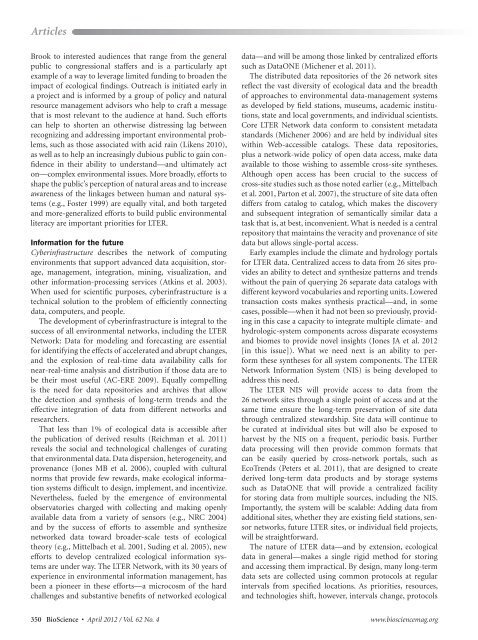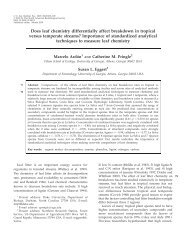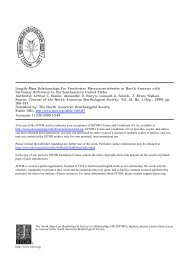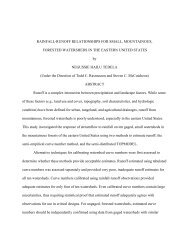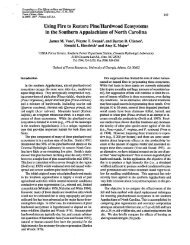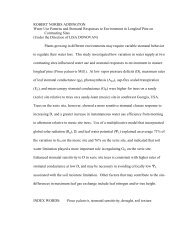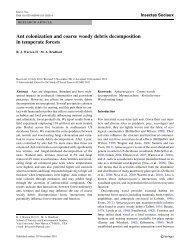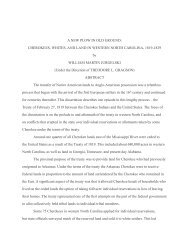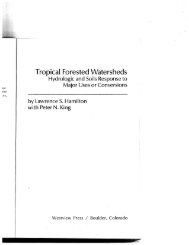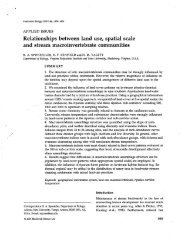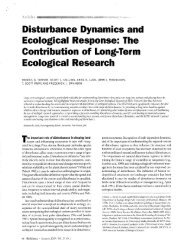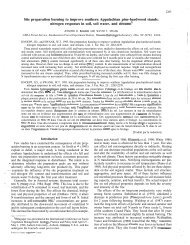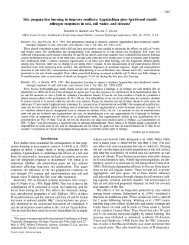biology join - Coweeta LTER - University of Georgia
biology join - Coweeta LTER - University of Georgia
biology join - Coweeta LTER - University of Georgia
You also want an ePaper? Increase the reach of your titles
YUMPU automatically turns print PDFs into web optimized ePapers that Google loves.
Articles<br />
Brook to interested audiences that range from the general<br />
public to congressional staffers and is a particularly apt<br />
example <strong>of</strong> a way to leverage limited funding to broaden the<br />
impact <strong>of</strong> ecological findings. Outreach is initiated early in<br />
a project and is informed by a group <strong>of</strong> policy and natural<br />
resource management advisors who help to craft a message<br />
that is most relevant to the audience at hand. Such efforts<br />
can help to shorten an otherwise distressing lag between<br />
recognizing and addressing important environmental problems,<br />
such as those associated with acid rain (Likens 2010),<br />
as well as to help an increasingly dubious public to gain confidence<br />
in their ability to understand—and ultimately act<br />
on—complex environmental issues. More broadly, efforts to<br />
shape the public’s perception <strong>of</strong> natural areas and to increase<br />
awareness <strong>of</strong> the linkages between human and natural systems<br />
(e.g., Foster 1999) are equally vital, and both targeted<br />
and more-generalized efforts to build public environmental<br />
literacy are important priorities for <strong>LTER</strong>.<br />
Information for the future<br />
Cyberinfrastructure describes the network <strong>of</strong> computing<br />
environments that support advanced data acquisition, storage,<br />
management, integration, mining, visualization, and<br />
other information-processing services (Atkins et al. 2003).<br />
When used for scientific purposes, cyberinfrastructure is a<br />
technical solution to the problem <strong>of</strong> efficiently connecting<br />
data, computers, and people.<br />
The development <strong>of</strong> cyberinfrastructure is integral to the<br />
success <strong>of</strong> all environmental networks, including the <strong>LTER</strong><br />
Network: Data for modeling and forecasting are essential<br />
for identifying the effects <strong>of</strong> accelerated and abrupt changes,<br />
and the explosion <strong>of</strong> real-time data availability calls for<br />
near-real-time analysis and distribution if those data are to<br />
be their most useful (AC-ERE 2009). Equally compelling<br />
is the need for data repositories and archives that allow<br />
the detection and synthesis <strong>of</strong> long-term trends and the<br />
effective integration <strong>of</strong> data from different networks and<br />
researchers.<br />
That less than 1% <strong>of</strong> ecological data is accessible after<br />
the publication <strong>of</strong> derived results (Reichman et al. 2011)<br />
reveals the social and technological challenges <strong>of</strong> curating<br />
that environmental data. Data dispersion, heterogeneity, and<br />
provenance (Jones MB et al. 2006), coupled with cultural<br />
norms that provide few rewards, make ecological information<br />
systems difficult to design, implement, and incentivize.<br />
Nevertheless, fueled by the emergence <strong>of</strong> environmental<br />
observatories charged with collecting and making openly<br />
available data from a variety <strong>of</strong> sensors (e.g., NRC 2004)<br />
and by the success <strong>of</strong> efforts to assemble and synthesize<br />
networked data toward broader-scale tests <strong>of</strong> ecological<br />
theory (e.g., Mittelbach et al. 2001, Suding et al. 2005), new<br />
efforts to develop centralized ecological information systems<br />
are under way. The <strong>LTER</strong> Network, with its 30 years <strong>of</strong><br />
experience in environmental information management, has<br />
been a pioneer in these efforts—a microcosm <strong>of</strong> the hard<br />
challenges and substantive benefits <strong>of</strong> networked ecological<br />
data—and will be among those linked by centralized efforts<br />
such as DataONE (Michener et al. 2011).<br />
The distributed data repositories <strong>of</strong> the 26 network sites<br />
reflect the vast diversity <strong>of</strong> ecological data and the breadth<br />
<strong>of</strong> approaches to environmental data-management systems<br />
as developed by field stations, museums, academic institutions,<br />
state and local governments, and individual scientists.<br />
Core <strong>LTER</strong> Network data conform to consistent metadata<br />
standards (Michener 2006) and are held by individual sites<br />
within Web-accessible catalogs. These data repositories,<br />
plus a network-wide policy <strong>of</strong> open data access, make data<br />
available to those wishing to assemble cross-site syntheses.<br />
Although open access has been crucial to the success <strong>of</strong><br />
cross-site studies such as those noted earlier (e.g., Mittelbach<br />
et al. 2001, Parton et al. 2007), the structure <strong>of</strong> site data <strong>of</strong>ten<br />
differs from catalog to catalog, which makes the discovery<br />
and subsequent integration <strong>of</strong> semantically similar data a<br />
task that is, at best, inconvenient. What is needed is a central<br />
repository that maintains the veracity and provenance <strong>of</strong> site<br />
data but allows single-portal access.<br />
Early examples include the climate and hydrology portals<br />
for <strong>LTER</strong> data. Centralized access to data from 26 sites provides<br />
an ability to detect and synthesize patterns and trends<br />
without the pain <strong>of</strong> querying 26 separate data catalogs with<br />
different keyword vocabularies and reporting units. Lowered<br />
transaction costs makes synthesis practical—and, in some<br />
cases, possible—when it had not been so previously, providing<br />
in this case a capacity to integrate multiple climate- and<br />
hydrologic-system components across disparate ecosystems<br />
and biomes to provide novel insights (Jones JA et al. 2012<br />
[in this issue]). What we need next is an ability to perform<br />
these syntheses for all system components. The <strong>LTER</strong><br />
Network Information System (NIS) is being developed to<br />
address this need.<br />
The <strong>LTER</strong> NIS will provide access to data from the<br />
26 network sites through a single point <strong>of</strong> access and at the<br />
same time ensure the long-term preservation <strong>of</strong> site data<br />
through centralized stewardship. Site data will continue to<br />
be curated at individual sites but will also be exposed to<br />
harvest by the NIS on a frequent, periodic basis. Further<br />
data processing will then provide common formats that<br />
can be easily queried by cross-network portals, such as<br />
EcoTrends (Peters et al. 2011), that are designed to create<br />
derived long-term data products and by storage systems<br />
such as DataONE that will provide a centralized facility<br />
for storing data from multiple sources, including the NIS.<br />
Importantly, the system will be scalable: Adding data from<br />
additional sites, whether they are existing field stations, sensor<br />
networks, future <strong>LTER</strong> sites, or individual field projects,<br />
will be straightforward.<br />
The nature <strong>of</strong> <strong>LTER</strong> data—and by extension, ecological<br />
data in general—makes a single rigid method for storing<br />
and accessing them impractical. By design, many long-term<br />
data sets are collected using common protocols at regular<br />
intervals from specified locations. As priorities, resources,<br />
and technologies shift, however, intervals change, protocols<br />
350 BioScience • April 2012 / Vol. 62 No. 4 www.biosciencemag.org


